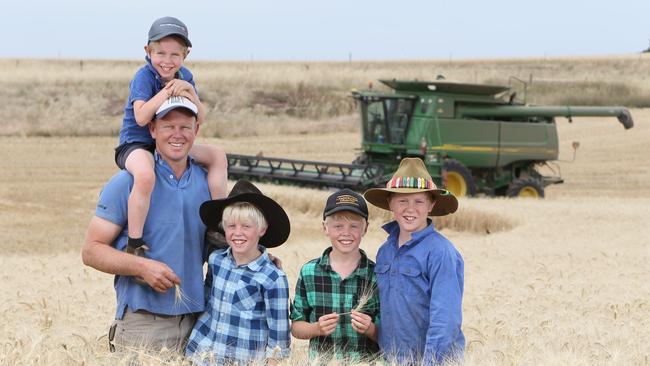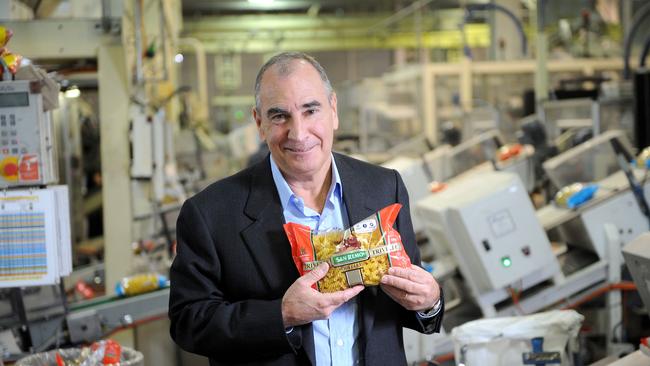Aussie pasta maker San Remo’s call to feed its ‘unlimited’ appetite
Australia’s biggest pasta-making business sowed its first seeds of national domination 30 years ago.

Ask the man managing Australia’s biggest pasta-making business how he likes his success and his answer may well be “al dente”.
After all, San Remo chief executive Maurice Crotti has spent the past 30 years bringing that “perfect bite” to households with the help of hundreds of durum wheat farmers, mainly in South Australia and Victoria.
Today, the business exports more than 700 products – all made from durum wheat – to 35 countries, including Italy, the home of pasta.
San Remo, which has mills in South Australia, Italy and Thailand, now wants growers to increase local production from 120,000 tonnes annually to at least 300,000 tonnes to feed its export ambitions.
“We have always been a company that is very firm in where we have come from and know our history, but always looking to where we are going,” Mr Crotti says.
“Pasta is now the third most eaten meal in the country – and we make most of the Australian pasta that is sold in supermarkets today.

“Our aim now is to develop the durum industry here to grow 300,000 tonnes of durum wheat for us here and for our mills overseas.”
While seasonal variations will influence final harvest outcomes, San Remo’s pasta production could potentially increase 30-40 per cent if the durum wheat supply ambitions are met.
Farmer Mathew Koch, 37, runs mixed-enterprise farms at Stockport and Leighton and is a second-generation supplier to San Remo.
“We grow mixed grains, legumes, durum and bread wheat, barley and run Merino sheep and prime lambs on our farms,” says Mr Koch, who joined the family business in 2008 after completing agriculture studies at the University of Adelaide.
“We are proud to grow durum for an SA company and see an opportunity in what San Remo wants to do,” he says.
“But the price paid for our quality durum going forward needs to have a price premium to compete for hectares with higher-yielding bread wheat and other enterprise choices.
“If that premium is not there, farmers simply won’t grow it no matter how good the finished product is.
“Although yearly tonnages vary due to weather and crop rotation, we grow a few hundred hectares of durum on our most fertile legume stubble paddocks each year as part of our cropping rotation.”
San Remo says it is creating a “collective opportunity” for the durum wheat industry in southern Australia to become a prime exporter of premium durum wheat at a global level.
Mr Crotti read the early signs well.
Coming back from a stint with a pasta maker in Italy in the late 1980s, he knew the business his grandfather, Luigi, started in 1936 would have to keep up with trends in Italy to survive.
“I knew that our competition in future was going to come from there,” Mr Crotti says.
“Pasta had to be made there (in Italy) from durum (not bread wheat) because the characteristic of the gluten was ideal for pasta and the al dente bite.
“We knew that’s the way we had to go and if we didn’t go that way, we wouldn’t have a business going into the future – we’d be washed out.”
The business worked with researchers and farmers testing different varieties to produce superior quality Australian durum that today demands a premium price.
“Two of the best wheats for pasta … come from the Arizona desert (US) and Australia,” Mr Crotti says.
When the milling plant in SA was set up in early 1990s, it was the first durum semolina plant in the South-East Asian region.
“We saw a future and belief in our product and we were ready to commit to the mill and we needed durum wheat to make our product,” Mr Crotti says. “With the help of farmers and researchers, we are now the largest users of durum wheat in the country.”
San Remo’s chief marketing officer, Erik de Roos, is fairly confident that the company’s growth is not limited to supermarket shelves in Australia and New Zealand.
“We are a No 1 imported pasta brand in Singapore, Thailand, Indonesia and the Philippines in addition to our thriving food services business,” Mr de Roos says.
“Not only are we exporting finished goods, there is also the opportunity for us to export raw durum wheat and semolina.”
He said the demand spike during COVID-19 was not linked to its new push for more durum.
“Rather it is simply the result of organic growth and wanting to minimise our reliance on imported durum wheat,” Mr de Roos says.
“For farmers, it simply means that if they have the supply, we have the appetite.
“We continue to expand internationally and, therefore, we offer unlimited growth potential.”






To join the conversation, please log in. Don't have an account? Register
Join the conversation, you are commenting as Logout